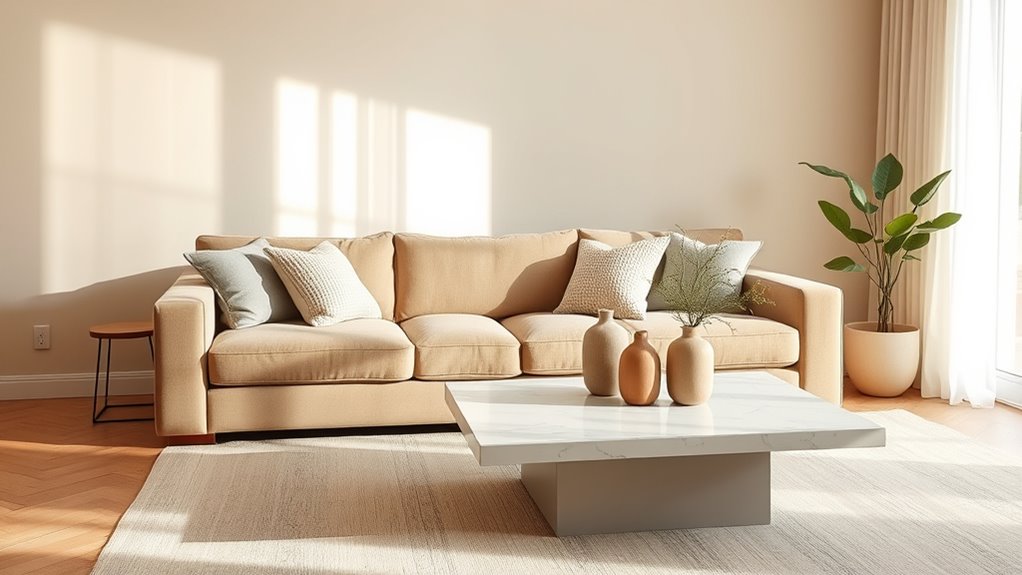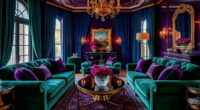Neutral colors aren’t inherently boring; they can be sleek, sophisticated, and calming. It’s all about how you style them—adding textures, layering shades, and choosing interesting finishes can turn a simple palette into a space full of depth and personality. Personal taste plays a big role, so you can create a look that feels timeless or understated, yet full of subtle elegance. Keep exploring, and you’ll discover just how dynamic neutrals can truly be.
Key Takeaways
- Neutral colors are often viewed as dull, but their versatility allows for dynamic styling with textures and accessories.
- Adding varied textures, shades, and finishes transforms neutrals from plain to sophisticated and engaging.
- Neutrals promote calmness and openness, making spaces feel serene rather than boring.
- Personal preferences and creative layering can elevate neutral palettes, making them unique and expressive.
- Thoughtful design choices turn neutrals into a timeless, adaptable foundation rather than a boring option.
The Perception of Boredom in Neutral Colors

Many people see neutral colors as boring because they lack the boldness and vibrancy that naturally draw attention. They often perceive neutral colors as dull, thinking they don’t stand out or make a statement. This misconception comes from limited use of textures, patterns, and layering with neutral shades, which can make a space or outfit feel monotonous. Personal reactions and emotional associations also play a role—some view neutrals as minimalistic or lacking personality. However, neutrals aren’t inherently dull. When combined thoughtfully with different textures, materials, and accessories, these colors can become dynamic and engaging. In fact, color psychology demonstrates how neutral shades can evoke calmness and sophistication, enhancing their versatility. Incorporating interior design techniques such as layering textures or mixing materials can transform neutral palettes into rich, inviting environments. Additionally, understanding the material diversity available in neutral tones allows for more creative and textured designs. Exploring space optimization strategies reveals how neutrals can serve as a versatile backdrop for creativity and style, highlighting other design elements without overwhelming the eye. Moreover, store hours information can help you plan your shopping trips to find the perfect neutral shades and textures in person.
How Neutrals Can Be Styled Creatively
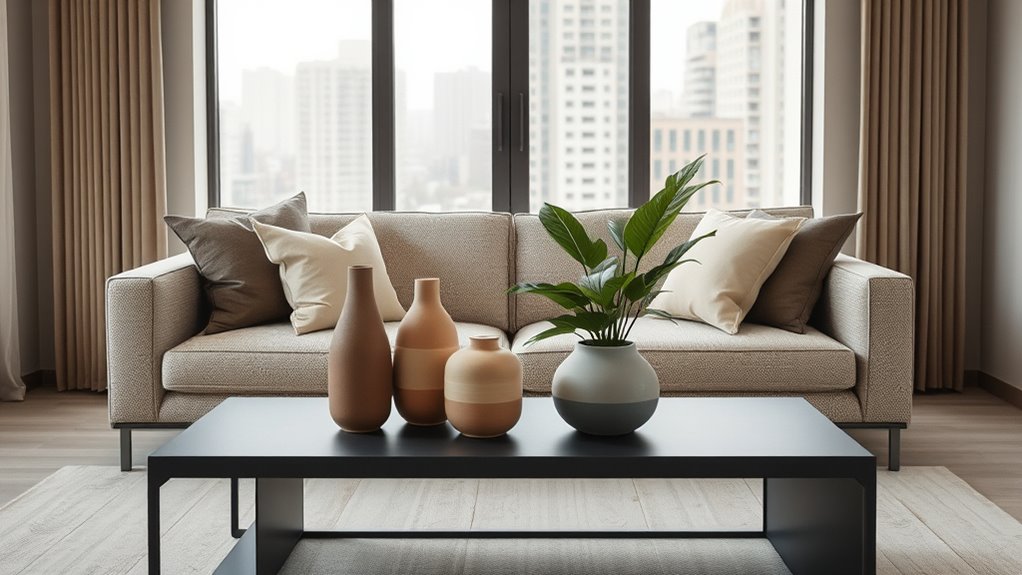
You can transform neutral colors from plain to mesmerizing by incorporating diverse textures and finishes. Mixing and matching fabrics like silk, velvet, and knits adds visual depth and tactile richness to your space or outfit. Layering neutral pieces with contrasting finishes—matte against glossy surfaces—creates a sophisticated, dynamic look. To keep neutrals interesting, play with a varied color palette within the neutral spectrum, combining taupe, beige, and gray for subtle complexity. Accessories also make a difference; vibrant scarves, jewelry, or bold lip shades elevate a neutral ensemble and prevent it from feeling monotonous. Incorporating patterned or textured neutral pieces, such as quilted jackets or textured upholstery, introduces visual interest while maintaining harmony in your overall design. When selecting dog names, considering their personality and appearance can help create a cohesive and charming aesthetic, much like choosing the right textures and finishes for neutrals. Paying attention to visual harmony ensures your styling choices remain balanced and engaging. Maintaining heat pump efficiency through proper sizing and regular maintenance is also crucial for a comfortable and energy-efficient environment. Additionally, understanding remote hackathons can inspire innovative virtual collaborations that keep your creative momentum going regardless of location.
The Psychological and Emotional Impact of Neutrals
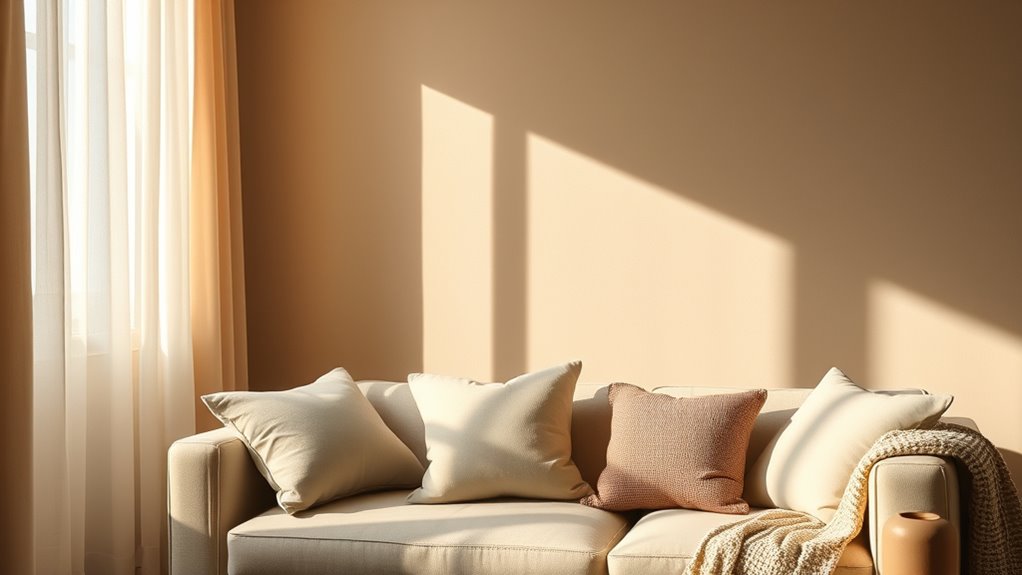
Neutrals have a powerful psychological effect, fostering feelings of calmness, serenity, and stability in any space. When you choose neutral colors like gray, beige, or taupe, you create an environment that promotes emotional comfort. These shades reduce cognitive load by minimizing emotional triggers, making you feel more relaxed and at ease. Color psychology also suggests that neutrals can influence perceptions of space, making environments feel more open and inviting. The subtle variations within neutral palettes influence your mood and the overall atmosphere, encouraging a balanced emotional response. Incorporating textures and finishes enhances both tactile and visual interest, deepening your emotional engagement with the space. Additionally, understanding the psychological impact of color can help you select neutrals that promote a sense of security and well-being. Recognizing how automation in business streamlines operations can further inform your choices in creating harmonious environments. Exploring the psychological effects of neutral tones reveals how these colors can positively shape your emotional experience. Engaging with emotional regulation techniques can also enhance your ability to maintain a calm and centered mindset in neutral environments. Overall, neutrals do more than look good—they positively impact your psychological well-being.
Mixing and Matching: Elevating Neutral Palettes
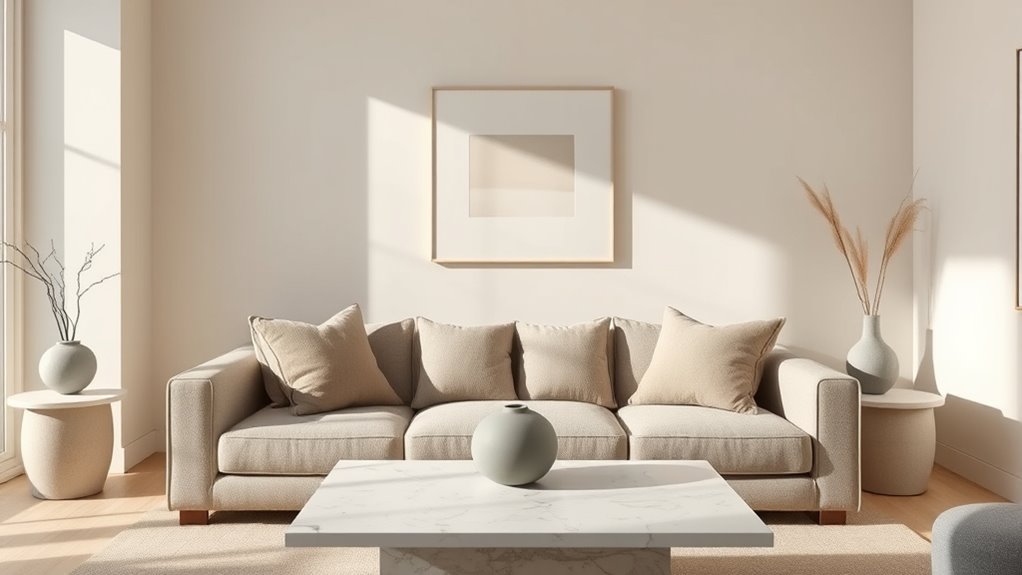
To elevate a neutral palette, mixing different shades, textures, and finishes is essential. Your favorite color might be a subtle taupe or a cool gray, but combining these can keep things interesting. Layering warm and cool neutrals, like pairing beige with slate, adds depth and dimension, preventing the space from feeling flat. Incorporate varied textures—matte walls, glossy accents, linen textiles, and wood grains—to enrich the overall look. Mixing finishes creates visual interest and keeps the palette lively. Using different neutral shades in furniture, accessories, and textiles allows you to keep things fresh and adaptable for any season. Incorporating natural materials such as wood, stone, and linen enhances authenticity and tactile appeal. Additionally, understanding self watering plant pots can inspire functional design choices that add both style and practicality to your space. Exploring the benefits of merchant account credit processing can also provide insights into smart financial management for your decorating projects, ensuring smooth transactions and secure payments. Incorporating spiritual decor elements can further deepen the sense of tranquility and positive energy within your neutral space. Strategic layering of these elements transforms a simple neutral palette into a sophisticated, dynamic space that’s anything but boring. Understanding neutral palettes helps in selecting the right combination to achieve a balanced and lively atmosphere.
Personal Preferences and the Versatility of Neutral Tones
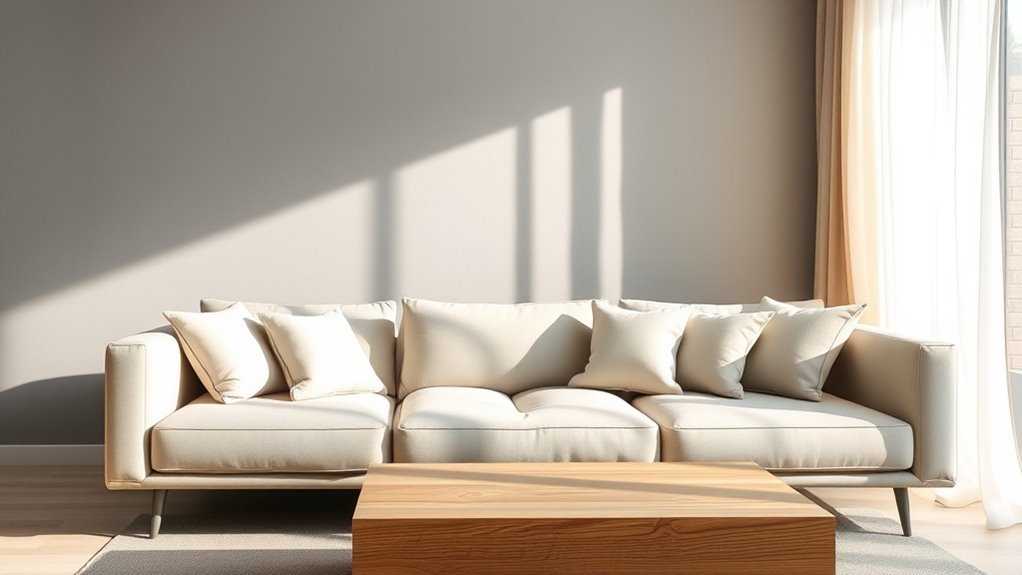
Personal preferences play a significant role in how you choose and use neutral tones in your spaces. Your individual taste influences whether you favor warm shades like camel and cream or cool tones such as grey and beige. Neutrals are highly versatile, serving as a flexible foundation that you can easily layer, accessorize, and adapt to match your mood or style.
| Personal Preferences | Neutral Tone Examples |
|---|---|
| Warm shades | Camel, Cream |
| Cool shades | Grey, Beige |
| Mood and style impact | Calm, Sophisticated |
This versatility allows you to craft a space that reflects your personality, whether you see neutrals as timeless or understated. Your personal opinion shapes how you perceive and incorporate these shades into your environment.
Frequently Asked Questions
How Do Neutrals Compare to Bold Colors in Interior Design?
When choosing between neutrals and bold colors, you should consider the mood you want to create. Neutrals offer a versatile, calming backdrop that complements various styles and allows accessories to stand out. Bold colors, on the other hand, inject energy and personality into a space, making it lively and memorable. Both options have their strengths, so think about your space’s purpose and your personal style to decide which suits you best.
Can Neutrals Work Well in Small or Dark Spaces?
You can definitely make neutrals work well in small or dark spaces. They reflect light, making the room feel brighter and more open, especially when paired with strategic lighting. Light neutrals like beige or soft gray create an airy feel, while darker neutrals add warmth without overwhelming the space. Use mirrors and accents to enhance brightness, and you’ll find neutrals can transform even the tiniest, darkest rooms into inviting retreats.
What Are Some Common Mistakes When Using Neutrals?
In your quest for perfect paint, you might forget that choosing neutrals isn’t a set-it-and-forget-it deal. A common mistake is selecting shades without considering undertones, which can clash or look dull. You also might overuse neutrals, making your space feel flat or uninspired. Avoid ignoring lighting conditions—they can alter how neutrals appear. Ultimately, failing to add pops of color or texture can leave your room feeling more like a museum than a cozy home.
How Do Neutrals Influence the Perceived Size of a Room?
Neutrals can make your room feel larger or cozier depending on how you use them. Light neutrals, like beige or soft gray, reflect more light, creating an airy, spacious vibe. Darker neutrals, such as deep taupe or charcoal, add depth but can make a space feel smaller if overused. To maximize your room’s perceived size, balance neutrals with strategic lighting and minimal clutter.
Are There Cultural Differences in How Neutrals Are Viewed?
Did you know that 65% of people in Japan prefer neutral tones for home decor, while only 40% in Italy do? You might find that cultural backgrounds influence how neutrals are viewed, with some cultures seeing them as calming and sophisticated, and others as dull or uninspired. So, your perception of neutrals can be shaped by your cultural environment, making them more than just boring shades—they’re a reflection of tradition and style.
Conclusion
Don’t let the idea of neutrals fool you—they’re far from boring. In fact, studies show that neutral-colored spaces can boost relaxation and productivity by up to 20%. When you get creative with textures, accessories, and layering, neutrals become endlessly versatile and personal. So next time you feel hesitant about choosing calm tones, remember that with a little imagination, neutrals can truly transform your space and mood for the better.
